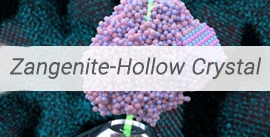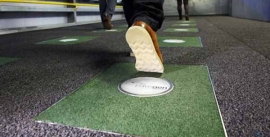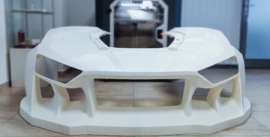 جدید
جدیدپوشش گرافن ، فولاد را در برابر خوردگی مقاوم می سازد!
پوشش گرافن ، فولاد را در برابر خوردگی مقاوم می سازد!
پوشش گرافن ، فولاد را در برابر خوردگی مقاوم می سازد!
یک گروه از دانشگاه Deakin، شبکه سه بعدی از نانوورق های گرافن را روی الیاف با اندازه میکرونی از فولاد ضدزنگ، رشد داده که هم مقاومت به خوردگی و هم هدایت الکتریکی آن را افزایش داد.
دانشمندان استرالیایی، نشان داده اند که اگر ورقه های گرافن به طور مستقیم روی فولاد ضدزنگ رشد کنند، آن را نسبت به خوردگی مقاوم می سازند، و با این کار توجهات را به صنعت پوشش (coating) جلب کرده اند.
روزی نیست که به کاربرد بالقوه دیگری از گرافن اشاره نشود. خواص منحصر به فرد آن باعث شده تا استفاده از آن در باطری ها، الکترونیک، سیستم های فیلتراسیون، مواد کامپوزیت و پوشش ها، توصیه گردد. در آخرین مقاله در همین راستا، یک گروه از دانشگاه Deakin، شبکه سه بعدی از نانوورق های گرافن را روی الیاف با اندازه میکرونی از فولاد ضدزنگ، رشد داده که هم مقاومت به خوردگی و هم هدایت الکتریکی آن را افزایش داد.
خوردگی فرآیند پیچیده ای است که هم به عوامل محیطی و هم به شرایط سطحی فلز (برای مثال زبری، مساحت سطح و حضور اکسیدها) بستگی داشته و اگرچه فولاد ضدزنگ نسبت به سایر فلزها نسبت به خوردگی مقاوم تر است، اما در محیط های اسیدی و مرطوب، ممکن است مستعد خوردگی موضعی باشد که منجر به ترک خوردن آن خواهد شد. در کار منتشر شده گروه Deakin در نسخه آوریل نشریه کربن (DOI:10.1016/j.carbon.2015.02.042) از ماهیت طبیعی آبگریزی گرافن استفاده شده است تا آب را از سطح الیاف فولاد ضدزنگ دفع کند. از طرفی خواص الکتریکی گرافن سبب کاهش احتمال رخداد واکنش های اکسایش- کاهش در سطح شده و از اکسیداسیون زیرلایه فلزی جلوگیری می کند.
گروه مذکور با هدایت Lingxue Kong، زیرلایه های آستنیتی بسیار متخلخل را – که حاوی تعداد مساوی از الیاف فولادی با قطر ۱۵ میکرومتر بودند- با شبکه ای از نانوورق های کربنی پوشش دهی کردند. با تنظیم دما و سرعت شار گاز در طول فرآیند رشد، ضخامت پوشش گرافنی به دقت قابل کنترل بود. ضخامت پوشش بدست آمده از چندلایه اتمی تا شبکه پیچیده ای از نانوپیلارهای به هم پیوسته کربنی تغییر می کرد، که سطح ویژه ماده را تا حد ۲۶۰۰۰ برابر افزایش می دادند.
مشخص شد که عدم یکنواختی ریزساختار فولاد ضدزنگ، علت ایجاد پوشش گرافنی با بلورینه شدن نامناسب بود. به علاوه، ترشوندگی ماده نیز مورد مطالعه قرار گرفت و مشخص گردید که وقتی نانوپیلارها بیشترین چگالی را دارند، فولاد پوشش داده شده، ابر آبگریز خواهد شد. همچنین مشخص شد که ماده در این حالت، بیشترین مقاومت به خوردگی را در برابر آب دریای مصنوعی داراست که این استنباط را در ذهن ایجاد می نماید که بدون در نظر گرفتن خواص یا ساختار ذاتی ماده فولاد ضدزنگ، حضور گرافن باعث افزایش مقاومت به خوردگی آن می گردد.
گروه مذکور انتظار دارند تا فولاد پوشش دهی شده آنها در مبدل های حرارتی، سیستم های جدایش مولکولی و مواد زیست سازگار، قابل کاربرد باشد.
منبع : materialstoday.com
ترجمه : عباس رمضانی
Graphene coatings make
steel corrosion-resistant
Australian scientists have demonstrated that graphene flakes grown directly onto stainless steel makes it resistant to corrosion, drawing the attention of the coatings industry.
Hardly a day goes by without mention of another potential application for graphene. Its unique combination of properties has seen it suggested for use in batteries, electronics, filtration systems, composites and coatings. In this latest paper, a team at Deakin University grew 3D networks of graphene nanoflakes on micron-sized fibers of stainless steel, improving both the metal’s resistance to corrosion and its electrical conductivity.
Corrosion is a complex process that is linked to both environmental factors and the conditions of the metal surface (e.g. roughness, surface area and presence of oxides). And although stainless steel is more resistant to corrosion than other metals, in acidic, aqueous environments, it can be susceptible to localized forms of attack that can result in cracking. Published in the April issue of Carbon [DOI: 10.1016/j.carbon.2015.02.042], Deakin’s work utilizes the natural hydrophobic properties of graphene to repel water from the surface of stainless steel fibers. In addition, graphene’s electrical properties reduce the likelihood of redox reactions occurring on the surface, preventing oxidation of the substrate metal.
Led by Lingxue Kong, the team coated highly-porous austenitic substrates – consisting of evenly-distributed 15µm diameter steel fibers – with networks of carbon nanoflakes. By tuning the temperature and feed gas flow rate during growth, the thickness of graphene coating could be tightly controlled. The resulting coating varied from a few atomic layers thick, to complex, interconnected nanopillars of carbon which increased the specific surface area of the material by up to 26,000 times.
The inhomogeneity of stainless steel’s microstructure was found to produce a graphene coating that was not highly-crystalline. In addition, the wettability of the material was also studied, and it was found that when the density of carbon nanopillars was highest, the coated steel was super-hydrophobic. The material also displayed its highest corrosion resistance to synthetic seawater at this point, suggesting that it was the presence of graphene that increased its corrosion resistance, without compromising the properties or structure of the native stainless steel material.
The team expect potential applications of their coated-steel to include thermal exchangers, molecular separation systems and bio-compatible materials.










دیدگاه کاربران